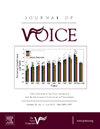单侧膈肌麻痹患者的发声影响
IF 2.5
4区 医学
Q1 AUDIOLOGY & SPEECH-LANGUAGE PATHOLOGY
引用次数: 0
摘要
研究目的本研究旨在调查单侧膈肌麻痹(UDP)患者通过诊断测试确认的可能的发声影响、对可能的发声障碍的感知程度及其与通气无力的相关性:研究人员对 70 人进行了分析、观察和病例对照研究,其中包括 35 名 UDP 患者和对照组中的 35 名健康患者,他们接受了以下评估:1)嗓音障碍自评(VHI-10);2)生活质量自评(SF-36);3)呼吸困难自评(MRC);4)客观发声测量(/a/、/s/、/z/的最大发音时间(MPT)和声门噪声激发比);5) 功能性呼吸压力(肺活量和最大通气压力); 6) 一般发音障碍程度--GRBAS 量表中的 G。性别、年龄和体重指数(BMI)是用于匹配研究样本的变量:与对照组相比,UDP 患者的功能模式受限,吸气无力,伴有呼吸困难症状,生活质量下降。当可能对声带造成影响时,这些患者会出现嗓音障碍,所有音素的 MPT 值都会下降,尤其是 /a/。发声表现与吸气无力之间也存在相关性。然而,值得注意的是,尽管存在发声障碍,但许多患者并未报告对这一事实的感知,在某种程度上忽视了这种障碍:结论:除了预期的呼吸肌无力外,UDP 患者的声带也受到了临床证实的影响,吸气无力程度越严重的患者,声带受损程度也越严重。最后,与此相关的是,并非所有患者都能感知到声带受到影响,这表明 UDP 患者对声带受损的感知程度非常低。本文章由计算机程序翻译,如有差异,请以英文原文为准。
Vocal Impact in Patients With Unilateral Diaphragmatic Paralysis
Objectives
This study aimed to investigate the possible vocal impact confirmed by diagnostic tests, the degree of perception of possible vocal impairment by patients with Unilateral Diaphragmatic paralysis (UDP) and its correlation with ventilatory weakness.
Methods
The researchers conducted an analytical, observational and case-control study with 70 individuals, including 35 UDP patients and 35 healthy patients in a control group, who underwent the following assessments: 1) Self-assessment of voice handicap (VHI-10); 2) Self-Assessment of Quality of Life (SF-36); 3) Self-Assessment of Dyspnea (MRC); 4) Objective vocal measures (Maximum Phonation Time (MPT) in /a/, /s/, /z/ and glottal-to-noise excitation ratio); 5) Functional respiratory pressures (Spirometry and maximum ventilatory pressures); 6) General degree of dysphonia – G on the GRBAS Scale. The sex, age and body mass index (BMI) of the individuals were the variables used to match the sample of this study.
Results
When compared with controls, patients with UDP had a restrictive functional pattern and inspiratory weakness, with symptoms of dyspnea and worsening quality of life. When associated with a possible vocal impact, these patients had voice handicap and decreased MPT values for all phonemes, especially /a/. There was also a correlation between vocal performance and inspiratory weakness. However, it should be noted that, despite having vocal impairment, many patients did not report the perception of this fact, somehow neglecting such impairment.
Conclusions
In addition to the expected weakness of the ventilatory muscles, patients with UDP had clinically verified vocal impact, and those who had greater inspiratory weakness also had greater voice impairment. Finally, it is relevant that not all patients perceived such vocal impact, which showed a very reduced perception of this impairment in patients with UDP.
求助全文
通过发布文献求助,成功后即可免费获取论文全文。
去求助
来源期刊

Journal of Voice
医学-耳鼻喉科学
CiteScore
4.00
自引率
13.60%
发文量
395
审稿时长
59 days
期刊介绍:
The Journal of Voice is widely regarded as the world''s premiere journal for voice medicine and research. This peer-reviewed publication is listed in Index Medicus and is indexed by the Institute for Scientific Information. The journal contains articles written by experts throughout the world on all topics in voice sciences, voice medicine and surgery, and speech-language pathologists'' management of voice-related problems. The journal includes clinical articles, clinical research, and laboratory research. Members of the Foundation receive the journal as a benefit of membership.
 求助内容:
求助内容: 应助结果提醒方式:
应助结果提醒方式:


